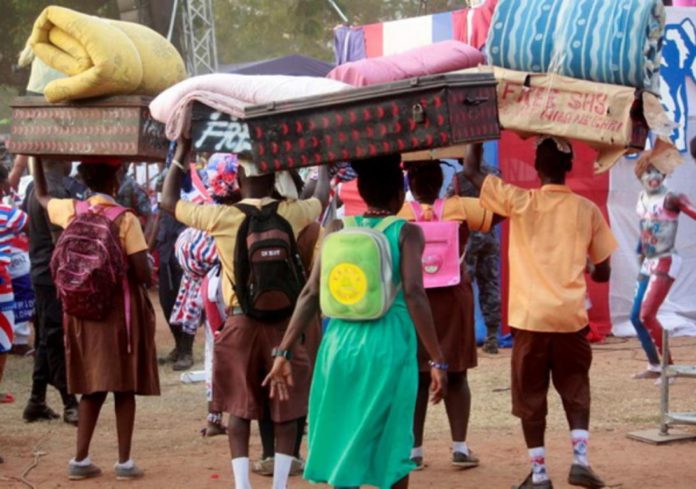“Children must be safe and feel safe in school; only then can they truly learn.”
— Arne Duncan (Former U.S. Secretary of Education, 2009 – 2016)
Introduction
Ghanaian schools, once regarded as safe havens for learning and discipline, now face an alarming wave of violence that threatens education at all levels.
From senior high schools (SHSs) to universities, conflict, weapon possession, and serious fights have created fear and uncertainty for students, teachers, and communities.
Incidents of School Violence
In January 2025, clashes broke out between Accra Technical Centre and Kinbu Secondary Technical School, followed by a machete fight between Kumasi Technical Institute and Kumasi Anglican SHS.
Again, February recorded a stabbing at Salaga SHS, where police recovered a pistol and ammunition, arresting 20 students. Also, Sokode SHS in the Volta Region was shut down after violent confrontations with residents.
Tragedy struck Adventist SHS at Bantama in April, when second-year student Suzzy Pinamang suffered a permanent eye injury after a male classmate allegedly brought a gun to class and accidentally discharged it.
In June, ethnic tensions at Nkwanta SHS in the Oti Region claimed three lives: two girls shot on their way home and a boy killed by a stray bullet in class.
July brought a grim succession of incidents as Bawku SHS became a centre of tragedy when final-year student Hakim Kundima was fatally shot on campus.
That same day, two students at Nalerigu SHS were killed in related shootings. While it can be said that these occurred in conflict areas, school violence is no longer confined to conflict zones.
The month also saw a fatal stabbing over money at St. Joseph Technical Institute, the killing of a Wa T.I. Ahmadiyya SHS student after a quarrel over an unwanted video, chaos at Zuarungu SHS over a stolen phone, and a viral video from Accra Academy showing students attacking a junior with a cutlass.
The violence has also reached tertiary institutions. In February, Kwame Nkrumah University of Science and Technology was shaken by the suspected murder of final-year student Joana Deladem Yabani.
A University of Energy and Natural Resources student survived a machete attack while returning from night classes in March.
In contrast, gunmen killed one student and injured another at Gambaga College of Education. Also, in April, a first-year student at the University of Education, Winneba, died by suicide.
Teachers have also become targets. Assaults on educators are increasing, with unions accusing authorities of inaction and advising members to withdraw services when threatened.
When those entrusted with shaping young minds cannot feel safe, the foundation of education begins to crumble.
Causes of School Violence
The drivers of this surge in violence are complex: weak discipline enforcement, peer pressure, poor parental supervision, social media glorification of aggression, and easy access to illegal weapons.
In troubled areas like Bawku, machetes, pangas, and guns have entered campuses.
Response by Authorities
In Bawku and Nkwanta (Oti region), authorities closed all affected schools, evacuating students preparing for the West African Senior School Certificate Examination (WASSCE).
The Small Arms Commission and Peace Council are working to curb the flow, while the GES and National School Inspectorate Authority have intensified code-of-conduct enforcement, inspections, and security agency collaboration.
Education Minister Haruna Iddrisu’s July 2025 directive for urgent inspections and disciplinary action signalled official recognition of the crisis.
Consequences of School Violence
The cost is profound: lives lost, physical and psychological trauma, eroded trust between teachers and students, and disrupted academic activities.
Beyond discipline issues, these attacks undermine education’s mission to provide safe, supportive spaces for growth and social cohesion. Closures and curfews derail exam preparation, while repeated exposure to violence leaves students traumatised, affecting attendance and performance.
Way Forward
Addressing this siege demands a comprehensive approach, stronger campus security, peer mediation, counselling, positive student leadership, and deeper parental and community involvement.
Ethnic and communal disputes that spill into schools must be addressed at their roots. Securing campuses must be non-negotiable, with long-term measures like risk mapping, reinforced perimeters, and rapid-response systems.
Alternative learning platforms, from radio lessons to safe temporary sites, should ensure education continues during crises (activating Education-in-Emergencies should be non-negotiable).
Schools must also rebuild civic responsibility. Discipline should be firm but fair. Counselling services should be expanded, and teachers trained in trauma-informed care and conflict resolution.
The justice system must act decisively; those who bring weapons to school or orchestrate attacks must face swift consequences. “Investigations are ongoing” will not save the next student. When impunity ends, deterrence begins.
Conclusion
Ghanaian schools are at a crossroads. Ending this siege requires not just soldiers at the gates but a collective refusal by parents, chiefs, pastors, and policymakers to normalise violence.
If we lose the classroom as a place of peace, we will lose more than exam results and the very citizens who can hold our democracy together. That is a price the nation cannot afford to pay.
Source: Mabel Darko Boateng
*** The writer is a Communications Associate with the Institute for Education Studies (IFEST_Ghana), an education think tank in Ghana.


